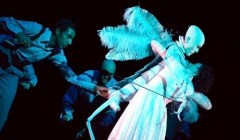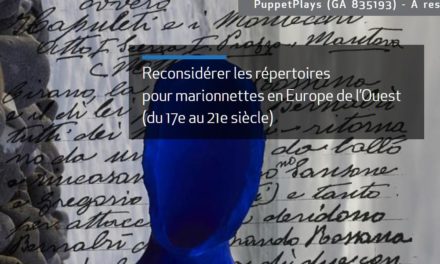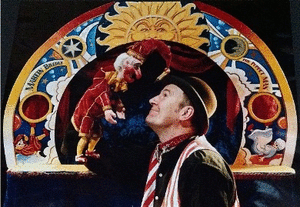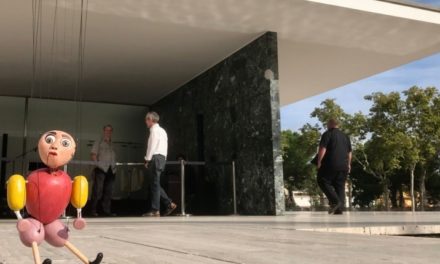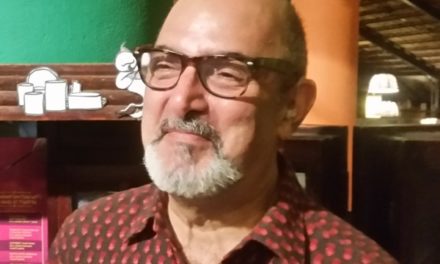It would be quite possible to recount the history of theatre and theatrical arts from the point of view of journeys. In every period and civilisation, theatre, like culture as a whole, has travelled more or less visibly or secreted amongst ideologies and spices, between people and precious materials. Puppets, objects of a naturally nomadic nature, have journeyed there and back on many occasions, crossing continents and seas. Chiwara, Hanuman, Polichinella or Karagoz are veterans of those immeasurable routes, by camel, boat, horse, car, aeroplane…
In the 60’s of the past century a fascinating and pioneering experiment happened, which perhaps hasn’t yet been rightfully recognised in the history of our profession: the Alexandre expedition, a trip around the world in search of puppets and puppeteers. It was a lovely, brave undertaking at a time before anyone talked about globalisation, when crossing continents by road could be a risky business, when we lived without the internet; a time in which mobile phones, GPS or social networking were not part of the way we related to each other or had anything to do with everyday objects.
The project was led by Philippe Genty, scarcely twenty-six years of age. He wasn’t yet the “global puppeteer” who tours successfully around the world or takes his shows to the Avignon Festival and to Paris’s Théâtre de la Ville or Palais de Chaillot theatres. Genty at that time was a shy young man, eager to get away from the reality of his life back home and who hardly knew anything about the art of puppetry. His partners in this adventure were the French photographer Yves Brunier and, later, the Japanese puppeteer Michiko Tagawa.
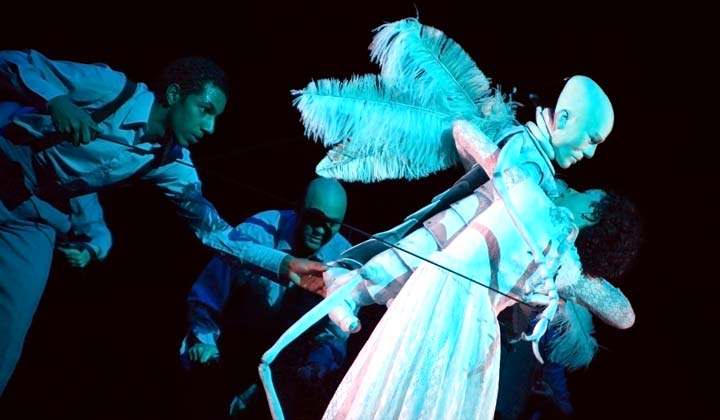
The work of Philippe Genty. Photo by Jesús M. Atienza.
The great journey
The starting point for this round-the-world puppet journey was Genty’s discomfort with his surroundings. The death of his father when he was six, for which he blamed himself for a long time, his involuntary nomadism through sixteen boarding schools from which he always ended being expelled, his unfinished studies in Applied Arts, as well as a real shyness and problems communicating with others, forged in Genty a permanent need for “forward flight” which explains the impulse that led him to make this round-the-world trip known as the Alexandre Expedition. “I needed to run away, it’s true, but with a sort of bulimia for spaces, dreaming of spaces which attracted me.” (1)
He spent two years preparing for the expedition. He made a string puppet, Alexandre, who represented a journalist. This puppet would go to meet his relations in other parts of the world. Genty recounts that the puppet started out with a complex number of strings that constantly got tangled up, and had a system of pulleys and technical gadgetry for the performance of a particular piece between Alexandre and a butterfly; all of which would end up being simplified to the utmost, motivated by the advice of Alain Recoing and Jacques Lecoq and by the reality of a wandering life that proved to be different every day.
To fund his journey, he asked UNESCO for financial assistance, and he convinced the administrators not with a typical dossier which sets out the project’s objectives, but with a brief performance of Alexandre. In the framework of a larger project called East-West, UNESCO provided a camera and film; in return, the young people were to collect photographs and film and send them to Paris. Genty and Brunier also had funding from the Alliance Française, the AFAA (Association Francaise d’Action Artistique) and the Bibliothèque de l’Arsenal (Library of the Arsenal), as well as from private firms that loaded them with cine film and photographic disposables, camping equipment, spare parts for their car, and so on. The vehicle was a Citroën 2CV, in which they set off to discover the puppets of the world; they covered 130,000 kilometres and crossed forty-seven countries in Eastern Europe, the Middle East, Asia, Australia, South America, Central America and North America, between 1962 and 1966.
This expedition resulted in an unprecedented documentary collection about the art of puppets. Its members also gave conferences and performed with Alexandre, who was the gagne-pain, the medium through which they supported themselves during the journey. The numbers that sum up this four year long expedition are eloquent: seven hundred photographs, six thousand five hundred metres of colour film, sixty conferences, five hundred performances, and endless international radio and television emissions.
Genty admits it was in Asia that he became enamoured of puppets: “From the theatre of giant silhouettes of Andra Pradesh to the Bunraku of Osaka, via the string puppets of Rajastan, I had the good luck to assimilate so many strong images on that journey in the 2CV. We crossed deserts and travelled along endless tracks through the jungle. One has to have been enveloped by the Malaysian monsoon for several days to become fully immersed in the climate of a performance of Wayang Kulit deep in a tropical forest. The same forest in which the Ramayana developed, the epic of gods, demons and men, told with the silhouettes of the shadow puppet theatre.” (2)
Within the vast Asiatic territory and its theatrical richness, it was in Japan that Genty experienced a powerful shock, which he explains in the following way: “I was staying at the home of a string puppeteer. He was an excellent sculptor who sometimes made heads for Bunraku puppets. Much of my time there was spent making a puppet. (…) I discovered a very important notion which we later used in our shows: the question of proportions. Contrary to many puppeteers who make large heads in relation to the bodies, in Bunraku the proportions are completely inverted: the head-size is contained between eight and nine times in the size of the body; this relation means that the body on stage seems impressively large.” (3)
In Japan, Genty also met Michiko Tagawa, a pupeteer from a traditional group; she decided to join the expedition and added a scene to the show with a Japanese aesthetic style. A little Samurai began to accompany Alexandre and the other marionettes on their journey along the puppetering routes. The Alexandre expedition proved to be a fascinating school “on the hoof”, in both artistic and human terms. They frequently had to act in precarious conditions in order to scrape together enough money to be able to eat and go on filming. Numerous anecdotes could be told about the thousand and one things that happened to these young people who went in search of the world’s puppets and puppeteers, at times risking their very lives. In Ecuador, for example, in the middle of the Andes the car skidded and crashed, flinging Michiko out. The Japanese woman saved her life but she was in hospital for months with serious problems of mobility. They also lost their cameras, the typewriter, money, journey notes and other belongings in the accident. In Guatamala they once more lost everything, vehicle included, because the 2CV got stolen! This scare had a lucky outcome, however, since Colonel Peralta himself, the country’s president, intervened, supervising an operation in which the thieves returned the car and other belongings to the foreigners.
Alexandre went to meet puppeteers, and his path crossed with characters such as the Soviet leader Nikita Khrushchev, with Australian kangaroos in the middle of the night, and incandescent rocks in the crater of a volcano in Central America.
Closing the circle
Following their return to France, the documentary was shown in 1969, entitled Around the world with puppets. The images allowed the viewer to discover shadow puppets from Java, Thailand and India, the Bunraku puppets of Osaka and the Takedda-za marionettes, the sacred rod puppets of Laos and Mongolia, and many more. The film also showed the work of non-Asiatic puppets such as those of Serguei Obraztsov (ex URSS) and Jim Henson (USA).
Genty returned a trained puppeteer, worn-in by the force of the winds and seas of the world. He created his own company and continued his work, in which tradition provides the substratum for the modernity of his language. The Alexandre expedition was his school, his source of knowledge and experience, and we should understand the wealth of that adventure, also, for all that it transmits over and beyond its protagonists’ stories.
In Genty’s work, one perceives above all the influence of Bunraku, on both technical and aesthetic levels. The fact of having crossed such varied horizons was decisive in this artist’s writing. Let’s not forget that his productions are the result of his personal work as a dramaturg, deeply visual, poetic, and non-narrative. His journey around the world brought him face to face with the problem of diverse languages, and for this reason Genty began to give pride of place to image over word. The journey of initiation as an important theme is also a constant in his shows: characters who change spaces, always in search of their inner demons.
Philippe Genty has, in turn, influenced many puppeteers during his fifty year career, and throughout the course of his international tours. Furthermore, he has given workshops and become a master for various generations of puppeteers. His work is an eloquent example of the fertile intersection of tradition and modernity.
Today the world is a different place. Looking back, the abyss which separates us from the 60’s is huge. Paradoxically, while in practical terms travel is more accessible than ever, the idea of making a journey such as the Alexandre expedition seems an impossible utopia. It was a different way of travelling, of relating with others, of observing the world. Movement wasn’t subject to the “presentism” of today, nor were we so asfixiated by laws or ruled by an economic order that conditions our every act… It was still possible to take one’s time, to wait, to barter performances for a roof over one’s head, and to make a halt in the journey in order to learn with a traditional, master puppeteer. Today, many of these masters have died without leaving disciples, a reality that is one of the greatest threats to the survival of our art.
Some of its thousand-year-old forms are on the road to extinction, while others have already disappeared, such as the puppets that Genty discovered in Laos, for example.
It would be desirable that the documentary, the photos and other material collected by Genty, Brunier and Michiko, though already in the public domain, were still better known; to increase awareness of who we are, where we come from, of the richness of the legacy we are losing and, even more importantly, about what must be saved.
Notes
(1) Genty, Philippe; “Portrait de Philippe Genty par Christian Chabaud”, in Ça bouge, Revue du pôle de la marionnette en Essonne, No. 3, Autumn 2004, p. 10.
(2) Genty, Philippe; “Jean-Loup Temporal interroge Philippe Genty”, in UNIMA France, No. 81, September 1983, pp. 8-28.
(3) Genty, Philippe: “Portrait de Philippe Genty par Christian Chabaud”, in Ça bouge, Revue du pôle de la marionnette en Essonne, No. 3, Autumn 2004, p. 11.
Translation: Rebecca Simpson

